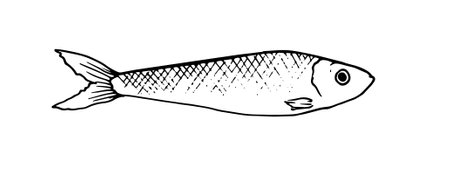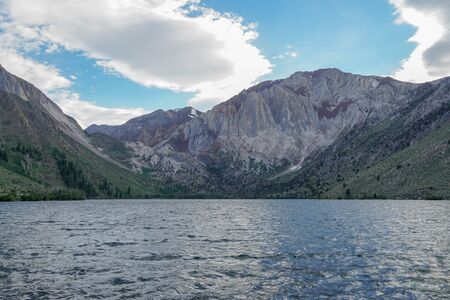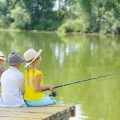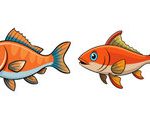1. Introduction to Trout Fishing in Montana
Montana has long been known as a fly fishing paradise, drawing anglers from all over the world to its legendary rivers and scenic landscapes. Nicknamed “Big Sky Country,” this western state offers some of the most pristine trout waters in the United States. Whether youre a seasoned fly fisher or just getting started, Montanas combination of natural beauty, healthy fish populations, and strong conservation ethics makes it a must-visit destination.
What sets Montana apart is its wide variety of cold, clean rivers and streams that are ideal for trout. These waters are home to several species of trout, including rainbow, brown, brook, and the native westslope cutthroat trout. The diversity of species means there’s always something biting, no matter the season.
Why Montana is a Fly Fishing Mecca
Montana’s reputation as a fly fishing hotspot isnt just based on fish numbers—it’s also about the experience. The state’s wide-open spaces, towering mountains, and crystal-clear rivers create an environment that feels untouched and wild. Its not unusual to spend an entire day on the water without seeing another angler.
Another big reason for Montana’s fly fishing fame is its strong culture of conservation. State agencies, local communities, and anglers work together to protect river habitats and fish populations. Catch-and-release practices are common, and many areas are managed with special regulations to maintain sustainable fisheries.
Main Trout Species Found in Montana
| Trout Species | Description | Common Rivers |
|---|---|---|
| Rainbow Trout | Known for their acrobatic fights and colorful markings | Madison River, Missouri River |
| Brown Trout | Larger and more elusive; prefer deeper pools | Bighorn River, Yellowstone River |
| Brook Trout | Smaller but beautiful; often found in mountain streams | Rock Creek, Blackfoot River |
| Westslope Cutthroat Trout | Montana’s native trout; known for their orange-red throat slash | Bitterroot River, Clark Fork River |
A Culture Built Around the Water
Fly fishing isn’t just a hobby in Montana—it’s part of the lifestyle. Small towns throughout the state host fly shops, guide services, and annual fishing events that bring communities together. Locals grow up learning how to cast flies before they learn to drive, and many families pass down secret fishing spots through generations.
This deep connection to the land and water helps preserve Montana’s natural resources. Anglers here understand that protecting rivers today ensures great fishing tomorrow. As you explore this guide to the best trout streams in Montana, you’ll discover not only where to fish—but why these waters matter so much to so many people.
2. Essential Gear and Tactics for Big Sky Fly Fishing
Fly fishing in Montana is more than just casting a line—its about matching the right gear and techniques to the unique challenges of Big Sky Country’s trout waters. From fast-flowing freestone rivers to spring creeks teeming with wary browns, having the right setup can make or break your trip.
Rods and Reels for Montana Waters
Montanas rivers vary greatly in size and current speed, so your rod and reel should match the environment. Heres a quick guide to help you choose:
| Water Type | Recommended Rod Weight | Rod Length | Reel Features |
|---|---|---|---|
| Small Streams (e.g., Rock Creek) | 2–4 wt | 76″–86″ | Lightweight, simple drag |
| Medium Rivers (e.g., Gallatin River) | 4–5 wt | 86″–9 | Smooth drag, good balance |
| Large Rivers (e.g., Missouri River) | 5–6 wt | 9+ | Larger arbor, strong drag system |
Flies That Work in Montana
The fly patterns that work best often depend on the season and specific river conditions. However, there are some time-tested favorites that consistently produce fish across the state:
| Season | Top Fly Patterns | Description/Use |
|---|---|---|
| Spring | Skwala Stonefly, Blue Wing Olive (BWO) | Skwalas hatch early; BWOs thrive on cloudy days. |
| Summer | Caddis, PMDs, Hopper Patterns | Caddis are prolific; hoppers shine mid-July through August. |
| Fall | Mahogany Duns, Streamers (e.g., Woolly Bugger) | Browns get aggressive pre-spawn—streamer fishing is hot. |
| Winter | Midges, Nymphs (e.g., Zebra Midge) | Tiny flies and slow presentations are key during cold months. |
Tactics Tailored for Montana Trout
Nymphing Techniques
Nymphing is effective year-round in Montana. Try Euro-nymphing on technical tailwaters like the Missouri River or use an indicator rig in deeper runs on the Madison.
Dry Fly Action
The dry fly opportunities in Montana can be epic—especially during summer hatches. Match the hatch carefully on rivers like the Bitterroot where trout can be picky.
Streamer Strategies
If youre after big browns, especially in fall, tie on a streamer. Target undercut banks and structure with sinking lines or weighted flies to get down quickly.
Know Before You Go: Local Regulations & Access Tips
Montana has excellent public access thanks to its stream access laws, but always double-check land ownership when entering from bridges or private property. A valid Montana fishing license is required for anyone 12 years old or older. Be sure to review seasonal closures and catch-and-release sections by checking with Montana Fish, Wildlife & Parks before your trip.
If youre planning to fish during spring runoff (typically late May through June), consider tailwaters like the Bighorn River which remain clear while freestones swell with snowmelt.
Pro Tip:
“When in doubt, go smaller.” Many seasoned Montana anglers downsize their tippet and fly size when dealing with pressured fish—especially on popular rivers like the Missouri or Paradise Valley spring creeks.
Selecting the right gear and techniques tailored to each rivers personality gives you the best chance at success—and makes every cast count under Montana’s big sky.

3. Top Blue Ribbon Trout Streams
Montana is home to some of the most legendary fly fishing waters in the United States, and its Blue Ribbon trout streams are at the heart of that reputation. These rivers not only offer incredible scenery but also world-class fly fishing opportunities for both beginners and seasoned anglers. Let’s take a closer look at four iconic rivers: the Madison, Missouri, Big Hole, and Bighorn. We’ll cover access points, major hatches, and the best times to fish each one.
Madison River
Known as the “50-mile Riffle,” the Madison River offers a mix of fast-moving water and deep pools that hold healthy populations of rainbow and brown trout. It runs from Yellowstone National Park through Ennis and down to Three Forks.
Access Points:
- Quake Lake to Ennis – great public access via Highway 287
- Ennis to Ennis Lake – float or wade-fishing friendly
Major Hatches:
- Salmonflies (late June – early July)
- Caddis (May – September)
- Blue-Winged Olives (spring and fall)
Best Times to Fish:
Late spring through early fall; early mornings in summer months are ideal due to warmer daytime temps.
Missouri River
The Missouri below Holter Dam near Craig is famous for its clear water, consistent flows, and large trout. It’s one of the most productive tailwaters in Montana.
Access Points:
- Craig, MT – central hub with boat ramps and fly shops
- Holter Dam to Cascade – several public access sites
Major Hatches:
- Pale Morning Duns (June – July)
- Tricos (July – August)
- Midges (year-round)
Best Times to Fish:
Spring and fall are prime times; winter midge fishing is also popular with locals.
Big Hole River
This freestone river offers wild trout in a remote setting with changing character along its course—from meadow stretches to fast canyon runs.
Access Points:
- Dewey to Divide – great floating section
- Melrose area – popular wade fishing spots
Major Hatches:
- Skwala Stoneflies (April)
- Salmonflies (late June)
- Caddis and Mayflies (throughout summer)
Best Times to Fish:
Late spring for stonefly hatches; late summer for terrestrial action like grasshoppers.
Bighorn River
The Bighorn below Yellowtail Dam is one of Montana’s most famous tailwaters. With cold, consistent flows year-round, it supports dense trout populations and prolific insect life.
Access Points:
- Around Fort Smith – numerous boat ramps and wade spots
- Bighorn Access Site – great for walk-in anglers
Major Hatches:
- Sowbugs and Scuds (year-round)
- Pale Morning Duns (summer)
- Midges (especially winter months)
Best Times to Fish:
The Bighorn fishes well all year, but summer dry fly action is hard to beat.
Quick Comparison Table
| River | Main Trout Species | Best Season | Main Hatch Highlight |
|---|---|---|---|
| Madison | Rainbow & Brown Trout | June – September | Salmonflies in early July |
| Missouri | Rainbow & Brown Trout | April – October | Pale Morning Duns in summer |
| Big Hole | Browns, Rainbows, Brookies, Grayling | May – September | Skwalas in spring; Salmonflies in June |
| Bighorn | Browns & Rainbows | Year-round (best in summer/fall) | Midges & PMDs in summer/winter mix |
If youre planning your next fly fishing trip in Montana, these rivers are must-visits. Each has its own unique charm—and challenge—but all deliver unforgettable days on the water under Big Sky Countrys endless skies.
4. Hidden Gems and Lesser-Known Waters
While Montana’s famous rivers like the Madison, Yellowstone, and Missouri draw anglers from across the country, there are countless lesser-known streams that offer incredible fly fishing opportunities without the crowds. For those willing to explore off the beaten path, these hidden gems provide solitude, stunning scenery, and surprisingly healthy trout populations.
Why Fish Lesser-Known Streams?
Fishing lesser-known waters means more than just avoiding other anglers. These streams often see less pressure, which can lead to more aggressive fish and a more relaxed fishing experience. Many of these spots require a bit of hiking or local knowledge to access, but the payoff is well worth it for adventurous fly fishers.
Top Underrated Trout Streams in Montana
Here are a few under-the-radar streams that locals love and visiting anglers often overlook:
| Stream | Region | What Makes It Special |
|---|---|---|
| Rock Creek (near Red Lodge) | South-Central Montana | A small freestone stream with excellent cutthroat and rainbow trout fishing in a rugged mountain setting. |
| Boulder River | Southwest Montana | Offers classic pocket water and easy wading access; brown and rainbow trout are plentiful. |
| Tobacco Root Streams | Southwest Montana | This range holds several small creeks full of wild trout and offers remote fishing experiences. |
| Ruby River (upper stretches) | Southwest Montana | The upper Ruby flows through scenic ranchland with strong hatches and wild browns. |
| Big Snowy Mountains Streams | Central Montana | Lesser-known alpine creeks with brookies and cutts in crystal-clear water. |
Tips for Exploring Hidden Waters
Do Your Research
Use topographic maps, regional fly shops, or online forums to identify access points and seasonal conditions.
Be Prepared to Hike
Many of these streams require some effort to reach. Wear good boots, pack light, and bring essentials like bear spray and plenty of water.
Practice Leave No Trace
These areas are special because they remain wild. Always pack out trash, respect private property boundaries, and minimize your impact on the environment.
Check Regulations
Lesser-known doesn’t mean unregulated. Be sure to check current Montana FWP regulations for stream-specific rules such as catch-and-release only sections or barbless hook requirements.
A Different Kind of Reward
Catching a trophy trout on a famous river is exciting—but theres something uniquely satisfying about discovering your own slice of paradise. Whether its a creek no wider than your rod tip or a hidden bend miles into national forest land, these quiet waters offer a deeper connection to nature and the art of fly fishing.
5. Planning Your Montana Fly Fishing Trip
Montana is a dream destination for fly anglers, but planning your trip right can make all the difference. From hiring local guides to finding the perfect place to stay, here are some essential tips and resources to help you get the most out of your trout fishing adventure in Big Sky Country.
Local Outfitters and Guides
Hiring a local outfitter or guide can greatly enhance your experience, especially if it’s your first time fishing in Montana. They know the hatches, river flows, and best spots that only locals talk about around the campfire.
| Outfitter Name | Region | Services Offered |
|---|---|---|
| Montana Angler | Bozeman Area | Guided float trips, walk/wade trips, lodging packages |
| The Rivers Edge Fly Shop | Gallatin Valley | Gear rental, guided trips, casting clinics |
| Yellowstone Angler | Livingston & Yellowstone River | Guided drift boat trips, gear sales, local reports |
Lodging Recommendations
You’ve got plenty of options when it comes to lodging—from riverside cabins to full-service fishing lodges. Booking early is key during peak season (June–September).
Types of Lodging
- Fishing Lodges: All-inclusive with meals and guide services—great for a worry-free trip.
- Cabin Rentals: More private and flexible—perfect if you’re traveling with family or friends.
- Campsites: Budget-friendly and close to nature—check USFS or BLM sites near popular streams.
Public Land Access and Stream Rights
Montana has some of the most angler-friendly stream access laws in the country. Most rivers are accessible up to the high-water mark as long as you enter from a public access point like a bridge or designated site.
Useful Public Access Resources:
- Montana Fish, Wildlife & Parks (FWP)
- USGS Streamflow Data
- OnX Hunt/Fish Apps – Public/Private Land Mapping Tools
Leave No Trace Principles
Treat Montana’s waters with respect so future generations can enjoy them too. Here are some basic Leave No Trace principles tailored for anglers:
- Pack It In, Pack It Out: Don’t leave behind tippet scraps, cans, or wrappers.
- Avoid Spawning Beds: Walk carefully in shallow water during spring and fall.
- Use Barbless Hooks: Makes catch-and-release easier on fish.
- Respect Wildlife and Other Anglers: Give space and keep noise down.
A well-planned trip means more time fishing and less time stressing. With these resources at your fingertips, you’re ready to explore Montana’s legendary trout streams like a pro.


